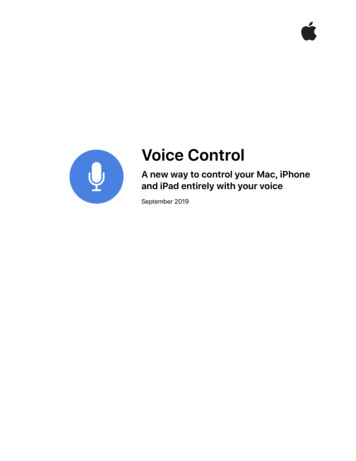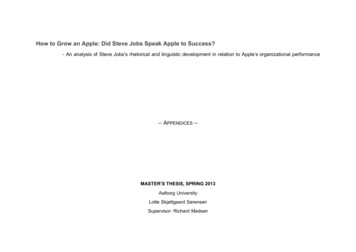
Transcription
Voice ControlA new way to control your Mac, iPhoneand iPad entirely with your voiceSeptember 2019
ContentsOverview . 3Speech-to-text transcription .3Text editing .4Comprehensive navigation .5Voice gestures .7Attention awareness .8On-device processing for privacy . 8Voice Control on macOS, iOS, and iPadOS .8Voice Control September 20192
OverviewKey FeaturesSpeech-to-text transcriptionThe Voice Control speech recognitionengine accurately understands andtranscribes natural speech, and userscan add custom words and commands.Text editingWith just their voices, users can selecttext with precision, make fine-graincorrections, and see alternative wordand emoji suggestions.Comprehensive navigationUsers can now access all parts of thescreen by saying item names andnumbers, using the grid overlay, andrecording multistep commands.Voice gesturesHand gestures like tap, double tap, andscroll are now voice activated, and userscan create customized voice gestures.Attention awarenessOn iPad and iPhone, users can wake upVoice Control and put it to sleep by justlooking at and away from their devices.On-device processing for privacyVoice Control audio processing happenson-device, so it works online or offlineand keeps personal information private.Voice Control is a new feature built into macOS Catalina, iOS 13,and iPadOS that empowers those who can’t use traditional inputdevices to control their Mac, iPhone, and iPad entirely with theirvoices. For users with motor limitations, having full voice controlof their devices is truly transformative.Voice Control offers an enhanced command and dictation experience. Userscan traverse and control the entire screen with just their voices, giving themfull access to every major function of the operating system. Additionally, userscan gesture with their voices to click, swipe, and tap anywhere—so they cando everything someone could do with a mouse or with touch. Voice Controlavailability on macOS, iOS, and iPadOS ensures a consistent experience forusers on all of their Apple devices.Speech-to-text transcriptionAt the core of Voice Control is its ability to understand voices. By integratingthe latest advances in machine learning for speech-to-text transcription,Voice Control is Apple’s best built-in dictation technology yet. For userswho can’t type with their hands, accurate dictation is essential for fast andefficient communication. The speech recognition engine in Voice Controlaccurately understands natural speech so that users don’t have to focus onsaying a phrase perfectly.By incorporating machine learning techniques focused on endpoint detection—or understanding when a user starts and finishes speaking—Voice Controldifferentiates between dictation and commands so that users can easily movebetween these two modes. For example, in Messages, if you say, “Happybirthday. Tap send.”, only “Happy birthday” is sent, just as you intended. Ifyou say, “Happy birthday. Delete that.”, “Happy birthday” is transcribed andthen deleted.Voice Control settings include customization options in the Commands andVocabulary tabs that make dictation even more powerful. Users can createcustom words to communicate specialized terms for school or work. This ishelpful when engaging in activities like writing a biology report, filling out atax form, or explaining a technical concept. Users can also create customcommands to save time, such as “insert home address,” to expedite the inputof their addresses or “insert mobile” to add their phone numbers.Voice Control September 20193
Text editingVoice Control in U.S. English is availableon iOS 13, iPadOS, and macOS Catalinaand leverages the Siri speech recognitionengine for accurate speech-to-texttranscription. On macOS Catalina,Voice Control is also available in all 40languages where Enhanced Dictationwas previously available.Voice Control builds on advanced dictation accuracy with a range of text editingcommands that enable users to quickly make corrections and move on toexpressing their next ideas. The main editing capabilities allow you to: Replace one phrase with another. For example, saying “Replace ‘I’m almostthere’ with ‘I just arrived’” will replace “I’m almost there” with “I just arrived.” Position the cursor to make edits. For example, you can say, “Move uptwo lines. Move forward two words. Capitalize that.” and Voice Control willcapitalize the specific word you indicated in the paragraph. This eliminatesthe need to delete entire sentences and start again. Select text with precision. You can select the exact text you want, from singlecharacters to an entire document. For instance, saying “Select previous word”will select the word right before the cursor, and “Extend selection backwardby one sentence” will widen the selection to include the entire sentence. View word and emoji suggestions. For example, if you recently dictated theword “love” but meant to input a different word or even an emoji, you cansay “Correct love,” and a list of alternative words and emoji will appear.You can also insert emoji by name—for example, “Insert thumbs-up emoji”will insert .Voice command in Messages on iOS 13: “Correct love.”Voice Control September 20194
Comprehensive navigationVoice Control gives users with motor limitations full and comprehensiveaccess to the user interface (UI), so they can easily traverse the screen andaccomplish complex actions with their voices, from dragging onscreen itemsto selecting unlabeled buttons. The tools that make every corner of the UIaccessible include: Navigation commands. Users can quickly interact with the system andapps through common navigation commands using their voices. Forexample, users can say “Open Apple Pay,” “Take screenshot,” “Mute sound,”“Save document,” “Search for item ” in Safari, or “Scroll up or down” inApple News. Item Numbers. In situations where users don’t have navigation commands,they can use a number overlay. Saying “Show numbers” assigns numbers toall clickable or tappable onscreen items, and users can then say a numberto select the item they want. Item Numbers automatically appear in menusand are especially useful for selecting unlabeled buttons and disambiguatingbetween a series of unnamed elements, such as photos.Voice command in Photos on iOS: “Show numbers.”Voice Control September 20195
Item Names. On iOS and iPadOS, Voice Control has the additional benefit ofshowing Item Names, which place a name next to each tappable item. Userscan say “Show names” to view the accessibility labels for apps, files, buttons,and links, then say the name of the item they want to interact with. Developerscan tag UI elements with Item Names and Item Numbers using the standardUIKit framework for views and buttons, which means users can have thesame experience in both native and third-party apps.1Voice command in Safari on iOS: “Show names.” Numbered Grid. For unlabeled elements that are unreachable through ItemNames and Item Numbers, users can use the grid overlay. Saying “Show grid”superimposes a grid with numbers on the screen, enabling users to iterativelydrill into a box on the grid and interact with the item it contains. NumberedGrid provides fine-grain control to accomplish tasks like dragging an itemto an unlabeled destination or dropping a pin in an undefined Maps location.With a grid overlay, users can also interact more deeply with apps that haven’tfully incorporated accessibility labels.Voice Control September 20196
You can find a comprehensive list ofVoice Control voice gestures for iOS 13and iPadOS in Voice Control settings.Here are some examples:Voice command in Maps on macOS: “Show grid.” Recorded commands. On iOS and iPadOS, users can record a multistep Swipe upprocess and give it a command name. For example, a user who frequently Swipe to bottomwatches soccer on the Apple TV app could create a recorded command to Two finger swipe left at 5*quickly view what games are on. The user would begin by saying, “Start Go homerecording commands,” then speak each step: “Open TV. Tap Sports. Scroll to Double tap Tap and hold at 7* Two finger double tap at 7* Long press at 14* Scroll to bottom Scroll to left edge Pan left Two finger pan right Rotate clockwise Rotate to portrait Zoom in Decrease zoom Zoom right Start drag at 10* Drop at 20* Drag from 6 to 13* Cancel gesturebottom. Tap Soccer.” Then the user would say, “Stop recording commands.”A prompt would appear asking the user to name the new command—forexample, “Browse soccer games.” From then on, if the user says, “Browsesoccer games,” the Apple TV app will automatically launch a view that showslive and upcoming soccer games.Voice gesturesOn iPhone and iPad, Voice Control enables users to perform Multi-Touchgestures like tap, double tap, and scroll up or down with their voices to fullynavigate the operating system without touching their devices. Users can alsorecord Custom Gestures. For example, an avid gamer could create commandsto jump, swipe, or tap specific areas onscreen. After saying, “Create newcommand” in Voice Control settings, the user would say “Action,” then“Run Custom Gesture” to open a recording screen. The user could keep theNumbered Grid on while saying “Drag number to number ” to create ajumping gesture, then say “Tap stop.” After naming the gesture—for example,“Jump up”—the user can say this name to enact the gesture while playingthe game.*The user has the Numbered Grid or Item Numbersturned on and is referring to specific numbers to moveitems across the screen.Voice Control September 20197
Attention awarenessOn iPhone and iPad models with the TrueDepth camera, Voice Controlintelligently activates and deactivates depending on where the user is looking.The TrueDepth camera projects and analyzes over 30,000 invisible dots tocreate a depth map of the user’s face and also captures an infrared image ofthe face. In addition to being used for Face ID, this data is also used to createthe Attention Aware function, which recognizes when users’ eyes are openand their attention is directed toward the device. With Attention Aware turnedon in Voice Control settings, Voice Control goes to sleep when users look awayfrom the camera and wakes up when users look toward the camera, enablingthem to easily move between interacting with their devices and with peoplearound them.2On-device processing for privacyApple believes that privacy should be equally accessible to all users, howeverthey interact with their devices. By leveraging the processing power ofApple’s A-series chips on iPhone and iPad and the unique silicon architectureof Mac, Voice Control audio processing happens on-device while maintainingfast performance. This keeps the words you use to control your devices private,from the messages you dictate and the news stories you tap to the websitesyou scroll through.An additional benefit of on-device processing is that Voice Control willalways function. Even if you’re out of cellular range or Wi-Fi is down,you have complete control of your device and can continue engaging inlocally based activities like writing, coding, editing images, and listeningto downloaded content.Voice Control on macOS, iOS, and iPadOSThe new Voice Control on macOS Catalina, iOS 13, and iPadOS vastly expandswhat users can achieve with their voices, from reaching the furthest cornersof the UI to engaging in apps more deeply than ever before. The cross-platformavailability of Voice Control provides a consistent experience across Mac,iPhone, and iPad, and on-device processing enables users to always haveaccess to their devices. For users with motor limitations, this powerful built-intool transforms how they work, play, create, and connect on Apple devices.What’s the difference between Voice Control and Siri?Voice Control lets users control the entire device with spoken commands andspecialized tools, while Siri is an intelligent assistant that lets users ask forinformation and complete everyday tasks using natural language. Voice Controloffers comprehensive capabilities such as voice gestures, name and numberlabels, grid overlays, text editing commands, and deep customization, while Siriassists with setting reminders, making appointments, looking up directions, andlearning game scores.Voice Control September 20198
Can you use Voice Control and Siri at the same time?Absolutely. For example, after setting up “Hey Siri” on iOS, a user can say,“Hey Siri, navigate me home,” and Siri will launch directions in Maps. Then theuser can use Voice Control commands like “zoom in” to interact with the map.Can anyone use Voice Control?Anyone can learn to use Voice Control. Some users might want to use just thedictation and editing elements of Voice Control, formerly known as EnhancedDictation on macOS, while others will want to use all Voice Control features.What if I just want to control my device and not use dictation?Users can say “Command Mode” to instruct Voice Control to ignore dictationand respond only to commands, and they can say “Dictation Mode” to instructVoice Control to listen for both dictation and commands.1 Developerscan visit ity/uiaccessibility to learn how to make theirapps even more accessible, beyond using standard UIKit controls and views. 2The TrueDepth camera is available oniPhone X and later models, as well as the 11-inch iPad Pro and 12.9-inch iPad Pro (3rd generation). 2019 Apple Inc. All rights reserved. Apple, the Apple logo, Apple Pay, Apple TV, iPad, iPad Pro, iPhone, Mac, macOS,Safari, Siri, Spotlight, and TrueDepth are trademarks of Apple Inc., registered in the U.S. and other countries. iPadOSand Multi-Touch are trademarks of Apple Inc. IOS is a trademark or registered trademark of Cisco in the U.S. and othercountries and is used under license.Voice Control September 20199
Voice Control is a new feature built into macOS Catalina, iOS 13, and iPadOS that empowers those who can’t use traditional input devices to control their Mac, iPhone, and iPad entirely with their voices. For users with motor limitations, having full voice c











